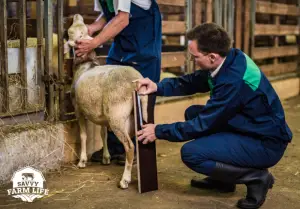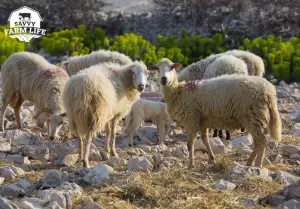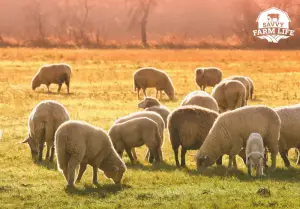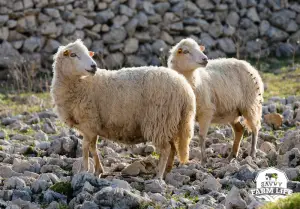Sheep Tails Guide
You may never have given much thought to a sheep’s tail before because most of the sheep you see grazing out in the pasture do not seem to have them. Is this because sheep are born without tails, or is this because a lamb’s tail is docked (amputated) at birth? There is a lot to know about sheep tails, and we have the answers you are looking for.
What should you know about sheep tails? Most breeds of sheep are born with tails that are docked upon birth, however some are born with naturally short tails or thin, hairless tails that do not require docking. While no one can argue that a lamb does not feel the pain of docking, most sheep farmers perform the procedure to protect the health of the sheep in the long run.
Read on to learn more about sheep tails, including what they look like, what they are used for, and why they are often docked.
Do Sheep Have Tails? 
Do sheep have tails? Sheep have tails, though the length will vary among breeds. The tail is known to be the most inheritable trait of a lamb, and is almost always the average length of the parents’ tails.
This means that if a sire has a long tail, and a ewe has a short tail, the offspring will have a tail of medium length. Hair sheep, such as the Katahdin and the Barbados Blackbelly, naturally have short tails and are often left un-docked by keepers. Other sheep, like the East Friesian, have what is affectionately called a “rat tail” – a long, thin tail without wool. Rat tails, too, are often left alone as there is no reason to dock them.
Aside from hair sheep and rat tails, most sheep have fatty tails that are covered in wool. Sheep tails hang down when relaxed, and are lifted for elimination. In fact, one of the ways you can tell the difference between a goat and a hair sheep is in the position of the tail – goats have tails that are held upright (think: deer), while sheep have a tail that points downward.
Fat-Tailed Sheep 
A percentage of sheep breeds are known as “fat-tailed” sheep. These are sheep that have especially fatty rumps and tails – they have been bred and used for thousands of years in the Middle East specifically for that tail fat, which is considered a delicacy (called “Allyah”) and was a popular cooking fat.
Fat-tailed sheep were a fascination to travelers who had not seen them, and were a hot topic for artists and historians. These tails were long and either curled or “paddle-shaped”. They were so large that many weighed up to 25 pounds, or 10-15% of the total carcass weight.
Along with fat-tailed sheep came “tail carts”. Many shepherds recognized the need for an apparatus to protect these long sheep tails that were dragging along the ground, and so they developed a sheep harness with rolling carts to lift and carry the tails. While fat-tailed sheep are still quite popular in many countries for their culinary offerings, most of their tails are of a more reasonable size and no longer require wheels.
The Purpose Of Sheep Tails
Sheep tails serve a couple of known purposes. Their main purpose is to protect the vulva and anus from the weather extremes. Without a tail, these sensitive areas would be exposed to high heat and/or severe cold, both of which can cause serious health problems. Even the breeds who are naturally short-tailed are not without tails, as they too must be able to take advantage of the protection that their tails offer.
Sheep will also use their tails as a form of pest management – similar to horses and other livestock, they will flick their tails side-to-side to discourage flies and other insects from landing. This is especially important for sheep, as they are highly susceptible to flystrike, an infestation that can quickly turn fatal.
Why Are Sheep Tails Docked? 
The primary reason that sheep tails are docked is to prevent flystrike. As we already touched on, flystrike is a serious condition to which sheep are highly prone. The high amount of fleece present on a sheep’s tail and rump is susceptible to soiling from urination and defacation. As the wool is soiled, green bottle flies are attracted to the area, where they will lay up to 1,000 eggs at a time.
When the eggs of the green bottle flies hatch, the hooked larvae will burrow into the sheep’s flesh so that they can eat. Once the flesh of the sheep is compromised, both blue bottle flies and black blowflies will become attracted to the area, causing the cycle to be repeated. By the time flystrike is recognized, the affected sheep is often already experiencing symptoms of ammonia poisoning due to the secretions of the larvae. Flystrike is often fatal, and when it is not, the treatment can be costly.
Sheep with docked tails are significantly less likely to become hit with flystrike. Few people who claim that docking is a cruel practice have seen an affected sheep. It is, therefore, considered both an ethical practice and good business management by many shephards in an environment where fly control is a seemingly losing battle (as is the case with most livestock).
How Short Should A Sheep Tail Be Docked?
If docking much of the length of the sheep tail helps to prevent flystrike, would removing the tail entirely prevent the deadly condition further? Over the years there has been much experimentation surrounding the length at which to dock, and it has been discovered that docking too much of the tail actually results in a higher risk of rectal prolapse.
You may wonder how the two are connected, but it all comes down to the muscles. Sheep regularly swish their tails (both short and long) and as such, have ample muscle development in the high end. When a sheep is missing this tail, the muscles are not adequately developed, and the sheep may be unable to control the muscles of the rectum.
For this reason it is important that should you choose to dock the tail, you dock no higher than the third palpable joint from the base of the tail (or for ewes, the tip of the vulva). There is no advantage but much risk in docking any higher.
Is Sheep Tail Docking Necessary?
As discussed, tail docking is highly effective in controlling flystrike. But are there other forms of control that do not involve docking the tail of a lamb?
Crutching or Shearing
Flystrike is prevalent in sheep because the sheep’s wool will harbor feces and urine, making the wool more attractive to flies. It stands to reason, then, that crutching (shearing the wool from around the vulva and anus) and shearing the tail should also be successful in deterring flies. While this may seem like a much less invasive technique to control flystrike, the argument could be made that it is not necessarily better for the sheep’s welfare.
Humans have bred sheep over the years to produce as much wool as possible. This means that to keep a sheep’s rear end adequately sheared, one must crutch at least every 6 weeks (every 3 weeks in cases of loose stool). Annual shearing has been proven to be a stressful, though necessary, event for sheep, and so catching, restraining, and crutching a sheep every 3-6 weeks may ultimately cause more stress to the sheep than the docking itself.
Mulesing
While mulesing is not exactly a cruelty-free alternative, we’ll explain the process as you may have heard the term. Mulesing is a (mostly outdated) process that involves cutting away strips of skin from the rear end of the sheep. The resulting scar tissue will not grow wool, which technically will help in the control of flystrike.
Mulesing is very painful and has a slow healing process, so there is quite a bit of controversy surrounding the practice. On top of that, most farmers who still use this practice also dock the tails, so it isn’t usually seen as an alternative, but rather an added procedure.
Controlling Flies
Since flies are the ultimate problem behind flystrike, controlling flies would greatly reduce the incidence of the condition. This can theoretically be achieved with chemical sprays, fly traps, and maintaining dry, clean establishments. While you can find many solutions to controlling flies online, anyone who lives on a farm will tell you that it is a lost cause – with livestock come flies.
Sheep Tails Are Uncommon For A Reason
Because of the unfortunate prevalence of conditions like flystrike, we can see why the idea of sheep having tails is foreign to many of us – because most of us never see sheep tails.
While the practice of docking may seem cruel at first glance, understanding the reasoning behind the procedure may change your mind, or at least give you some insight as to why most sheep don’t have tails. A farmer’s first priority will be the health and welfare of his sheep, and many believe this involves shortening the tails.

